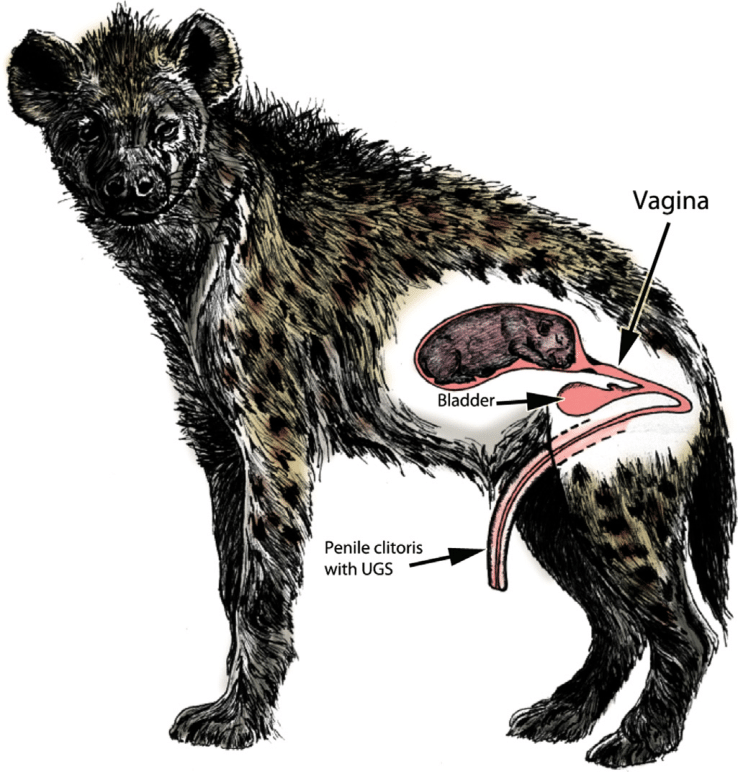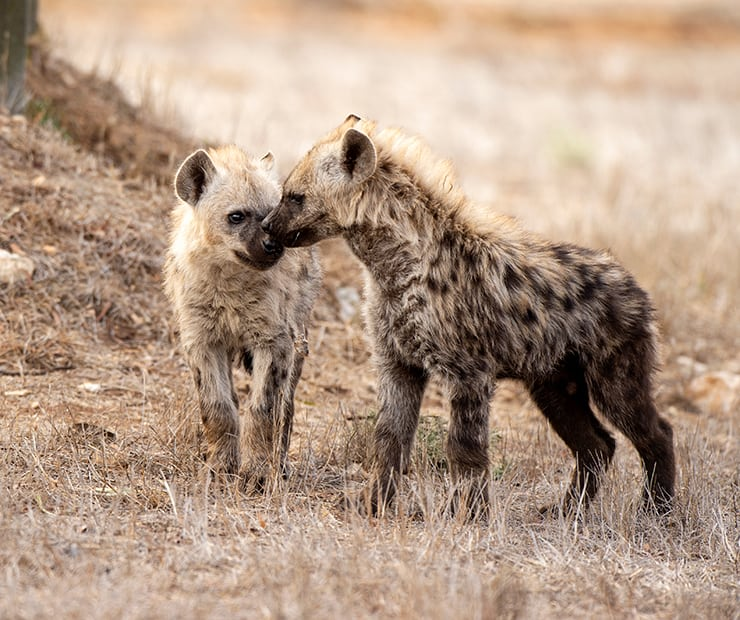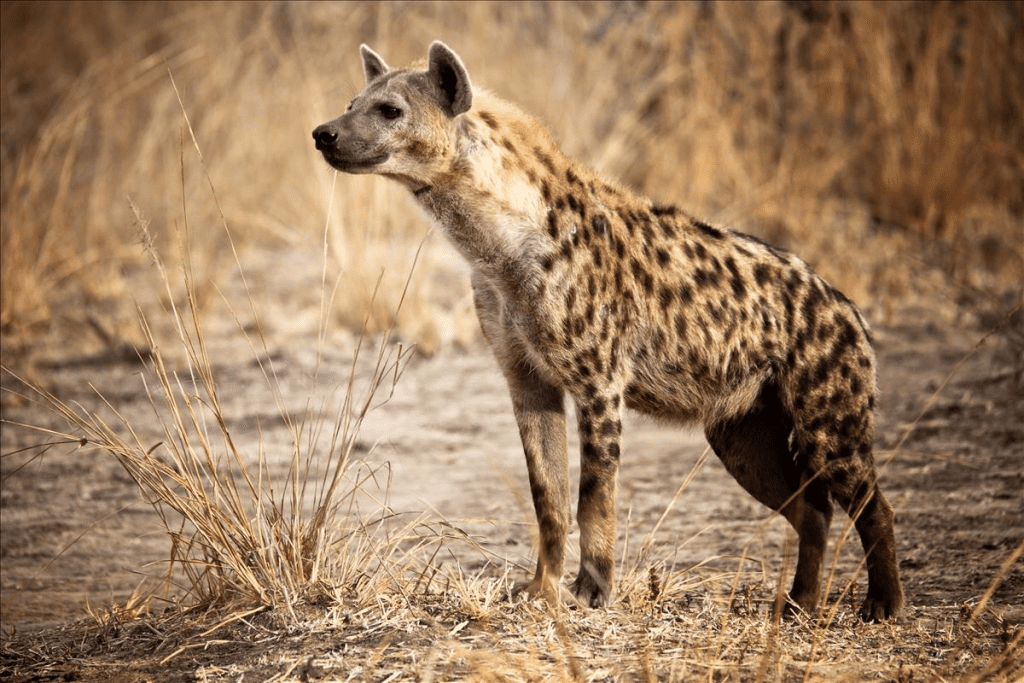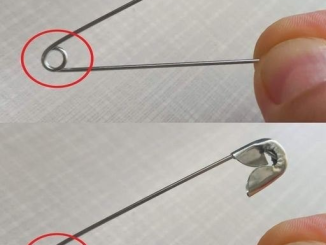Nature is full of fascinating and sometimes brutal adaptations, but few are as shocking as the birthing process of the spotted hyena. You might think childbirth is a universally painful experience, but hyenas take it to an entirely new level.
Female hyenas have one of the most unusual reproductive anatomies in the animal kingdom—what appears to be a penis is actually an elongated clitoris, known as a pseudo-penis. This rare adaptation makes mating, birth, and survival incredibly difficult for both mother and cubs.
Let’s dive into the science, struggles, and evolutionary mysteries behind why hyenas experience one of the most challenging births in the wild.
Hyenas’ Unique Reproductive Anatomy: A Bizarre Evolutionary Twist

The female spotted hyena (Crocuta crocuta) is unlike any other mammal when it comes to reproduction. Unlike most female mammals, hyenas have no external vaginal opening. Instead, their labia are fused together, forming a pseudo-scrotum, and their clitoris is elongated into what resembles a fully functional penis.
This means that both mating and giving birth happen through a narrow, tough, and inflexible canal—a structure that poses serious risks to both mother and cubs.
But why would evolution favor such an extreme adaptation? The answer lies in hyena social structure and dominance.
The Link Between Dominance and Reproductive Anatomy
Hyenas live in strict matriarchal societies, where females outrank males in dominance. The unusual reproductive anatomy is believed to be an evolutionary adaptation linked to social hierarchy.
- A Display of Strength: A larger pseudo-penis might act as a dominance signal, making it clear which females hold power in the clan.
- Hormonal Influence: Female hyenas have higher testosterone levels than males, leading to increased aggression and dominance over the pack.
- Mating Challenges: Males must earn the right to mate, as females control copulation with their complicated anatomy.
Video : Hyenas’ Brutal Birth: The Most Painful Labor in the Animal Kingdom
While this system gives females power, it comes at a terrible cost when it’s time to give birth.
Why Giving Birth Is So Dangerous for Hyenas
Imagine trying to push a newborn through a passage too small, too rigid, and highly prone to tearing. That’s exactly what female hyenas go through every time they give birth.
Here’s what makes hyena birth so deadly:
- A Super Tight Birth Canal
- The pseudo-penis acts as the only birth canal, but it is long, narrow, and lacks the elasticity of a normal vagina.
- This makes labor extremely difficult and painful, with a high chance of the tissue tearing.
- First-Time Mothers Face the Worst Risks
- Many first-time mothers do not survive the birthing process due to severe ruptures.
- Those who do survive often suffer from long-term damage to their reproductive organs.
- High Cub Mortality Rate
- A staggering 60% of hyena cubs suffocate before they are fully delivered.
- Since the birth canal is so tight, cubs often become trapped and die before they can emerge.
- A Painful Recovery Process
- After birth, the pseudo-penis often ruptures completely, forcing it to heal over time.
- Mothers suffer weeks of pain and vulnerability while their bodies recover.
Despite these brutal challenges, hyenas continue to thrive, and their unique reproductive system has remained largely unchanged for millions of years.
How Do Hyenas Mate? The Struggles of Reproduction

If you think birth is difficult for hyenas, mating is no easier. Males must overcome significant anatomical and social obstacles just to reproduce.
- Males Are Submissive to Females
- Unlike in many species where males dominate, male hyenas are the weaker sex in both power and ranking.
- They must approach females cautiously, often displaying submissive behavior to gain approval.
- Navigating the Pseudo-Penis
- Since females have no traditional vaginal opening, males must carefully maneuver through the pseudo-penis to copulate successfully.
- This requires both patience and precise positioning, making it one of the most complex mating processes in the animal world.
- Only the Strongest Males Get to Reproduce
- Males don’t fight each other for dominance like in other species. Instead, they must earn the female’s trust over time.
- Females choose mates based on persistence, patience, and respect, ensuring only the most determined males pass on their genes.

Given how dangerous and inefficient the reproductive process is for hyenas, one might wonder why evolution hasn’t corrected this issue.
The answer lies in survival strategy and social dynamics.
- Matriarchal Control Guarantees Stronger Cubs
- By limiting mating to only the most persistent males, female hyenas ensure that their cubs inherit strong genetics.
- This method prevents weaker genes from spreading, keeping the species robust.
- Higher Testosterone Helps With Survival
- The same high testosterone that makes birth difficult also makes female hyenas stronger and more aggressive.
- This aggression helps protect their cubs and maintain dominance in their environment.
- Fewer Cubs = More Resources
- Since many cubs don’t survive birth, the ones that do are often given more attention and resources.
- This ensures the strongest cubs make it to adulthood, increasing the clan’s overall survival rate.
The Resilience of the Spotted Hyena
Despite their brutal birthing process, hyenas have thrived for millions of years. Their ability to adapt, dominate, and survive proves just how powerful evolutionary trade-offs can be.
- They are among Africa’s most successful predators, competing with lions for food.
- Their clans are ruled by powerful females, ensuring only the strongest members survive.
- They have some of the most advanced social structures in the animal kingdom, making them highly intelligent and strategic.
Video : The Most Extreme Births In The Animal Kingdom
Conclusion: Nature’s Ultimate Test of Survival
Hyenas are proof that nature often prioritizes survival over comfort. Their unique reproductive anatomy, extreme birthing challenges, and dominance-driven society have allowed them to thrive despite overwhelming odds.
While their birth process remains one of the most painful and deadly in the animal kingdom, it also ensures that only the strongest females and cubs survive.
So the next time you see a spotted hyena, remember—they’re not just fierce scavengers. They’re survivors of one of evolution’s toughest reproductive challenges.
Minha enteada me deu um carro de presente no meu aniversário de 55 anos – quando abri o porta-luvas, fiquei pálido

Um carro da minha enteada Emily era a última coisa que eu esperava no meu aniversário de 55 anos, especialmente considerando nossa história. Ela me entregou as chaves, e eu pensei que era isso. Mas então ela mencionou outro presente escondido no porta-luvas. O que eu encontrei lá mudou nosso relacionamento para sempre.
Eu sempre disse que ser madrasta é como andar na corda bamba. Você está tentando equilibrar entre ser mãe e não passar dos limites. Entre amar incondicionalmente e respeitar limites.

Uma mulher chorando | Fonte: Pexels
Para mim, essa corda bamba tem sido minha vida nos últimos dez anos com minha enteada, Emily.
Conheci o pai dela, David, no meu local de trabalho. Eu era novo lá e ele me ajudou com muitas coisas. Nós nos tornamos amigos instantaneamente.
Agora que olho para trás, sinto como se o destino tivesse me dado meu novo emprego para que eu pudesse conhecer David. Tínhamos tantas coisas em comum, e levou apenas alguns meses para começarmos a namorar.

Um casal de mãos dadas | Fonte: Pexels
David me contou tudo sobre sua vida. Ele havia perdido sua esposa cerca de um ano antes de nos conhecermos, e sua vida girava em torno de sua garotinha, Emily. Ele a amava profundamente.
À medida que nosso relacionamento se fortalecia, não pude deixar de me perguntar sobre nosso futuro.
Uma noite, enquanto estávamos sentados na cadeira de balanço da varanda dele depois do jantar, decidi abordar o assunto.
“David”, eu disse, com o coração acelerado, “onde você vê isso indo? Nós, quero dizer.”
Ele se virou para mim. “Monica, eu te amo. Quero passar minha vida com você. Mas…”

Um close-up de um homem | Fonte: Midjourney
“Mas o quê?”, perguntei gentilmente.
“Quero me casar com você, mas estou preocupado com Emily. Não sei como ela reagiria a ter uma madrasta.”
Estendi a mão e peguei a dele. “David, vai ficar tudo bem. Minhas reuniões com Emily sempre foram boas. Ela é uma garota doce.”
“Você está certa”, ele disse enquanto sorria. “Emily parece gostar de você. Ela sempre pergunta quando você vem aqui em seguida.”

Uma menina | Fonte: Pexels
“Viu?” Apertei a mão dele. “Vamos dar um passo de cada vez. Emily e eu encontraremos o nosso caminho.”
“Você está certo. Nós faremos isso funcionar. Juntos.”
Quando me casei com David, eu sabia que estava entrando em uma situação complicada. Emily tinha apenas 12 anos, ainda sofrendo por ter perdido a mãe dois anos antes. Eu sabia que seria difícil para ela me aceitar como madrasta, mas pensei que as coisas iriam melhorar.
Eu estava errado.

Uma mulher sentada à mesa | Fonte: Pexels
Lembro-me da primeira vez que a conheci. Lembro-me de como seus grandes olhos castanhos me olhavam com preocupação.
“Oi Emily”, eu disse, tentando manter minha voz firme. “Eu sou Monica. É um prazer conhecê-la.”
“Oi”, ela murmurou, antes de rapidamente se desculpar e ir para seu quarto.
Aquele momento deu o tom para o nosso relacionamento. Eu tentei o meu melhor para estar lá para ela, mas Emily sempre pareceu me manter à distância.

Uma menina olhando para frente | Fonte: Midjourney
Não era que ela fosse má ou desrespeitosa. Não, era mais sutil do que isso. Ela era educada, mas distante, como uma convidada em sua própria casa.
Lembro-me do seu 13º aniversário. Eu passei horas decorando a casa e assando seu bolo de chocolate favorito. Quando Emily chegou da escola, seus olhos se arregalaram com a visão.
“Uau”, ela disse, com um pequeno sorriso brincando em seus lábios. “Isso parece ótimo. Obrigada, Monica.”
Foi um momento agradável, mas ainda havia aquela barreira invisível.

Um bolo de chocolate | Fonte: Pexels
Ela não me abraçou nem demonstrou muita excitação. Era como se ela estivesse se segurando, com medo de se deixar chegar muito perto.
Apesar dos desafios, David e eu tínhamos um bom relacionamento. Ele era paciente e sempre me encorajou a continuar tentando com Emily.
Nós éramos felizes. Tão felizes. Mas então, cinco anos atrás, meu mundo virou de cabeça para baixo.
David morreu em um acidente de carro, deixando Emily e eu sozinhos.
Ainda me lembro daquele dia terrível.

Uma mulher chorando | Fonte: Pexels
Eu estava sentado na sala de estar com Emily, e nós dois ficamos chocados.
“O que fazemos agora?” Emily perguntou com a voz trêmula.
Estendi a mão e peguei a dela.
“Nós ficamos juntos”, eu disse. “Somos uma família e vamos superar isso juntos, ok?”
Ela assentiu e apertou minha mão com força. Foi o mais perto que já estivemos, unidos em nossa dor.
Depois da morte de David, éramos apenas Emily e eu. Éramos a única família um para o outro.

Uma mulher abraçando sua filha | Fonte: Pexels
Eu nunca quis substituir a mãe dela. Eu só queria ser alguém em quem ela pudesse confiar.
Mas não importa quantos aniversários ou marcos comemoramos juntos, eu não conseguia me livrar da sensação de que ela apenas me tolerava. Era como se houvesse uma barreira invisível entre nós que eu não conseguia quebrar.
Conforme Emily cresceu, ela se tornou mais independente e passou muito tempo longe de casa. Ela finalmente conseguiu um ótimo emprego em marketing e estava indo bem para si mesma.

Uma mulher usando seu laptop | Fonte: Midjourney
Fiquei orgulhoso de suas realizações, mas também preocupado com a distância emocional que parecia ter aumentado ainda mais entre nós.
Sempre imaginei que teríamos um relacionamento amoroso, mas, em vez disso, nossas interações pareciam transacionais.
Houve momentos em que Emily mal reconhecia minha existência nas reuniões de família, e seu silêncio parecia um lembrete constante de que eu era um estranho em sua vida.
O último Dia de Ação de Graças me fez perceber que ela não valorizava minha presença.

Um jantar de Ação de Graças | Fonte: Pexels
Minha irmã e sua família tinham vindo, e Emily tinha chegado atrasada. Ela só deu um rápido olá antes de mergulhar na conversa com seus primos.
Minha irmã me chamou de lado quando percebeu isso.
“Está tudo bem com você e Emily?” ela perguntou.
“Ah, você sabe como são as crianças”, forcei um sorriso. “Ela só está ocupada com o trabalho e com a própria vida.”
Mas por dentro meu coração estava partido.
Eu queria muito estar perto dela, ter o tipo de relacionamento em que pudéssemos conversar sobre tudo e qualquer coisa.

Uma mulher triste | Fonte: Pexels
Avançando para a semana passada, pouco antes do meu aniversário de 55 anos.
Emily me ligou e disse que queria me levar para um jantar especial de aniversário. Fiquei emocionado. Normalmente, ela só me mandava um cartão e flores, mas isso foi diferente.
Fiquei me perguntando se isso era finalmente um sinal de que ela estava começando a me ver como mais do que apenas a segunda esposa de seu pai.
Ela me pegou em um elegante conversível vermelho.

Um conversível vermelho | Fonte: Pexels
No começo, pensei que ela estava apenas me pegando em um carro alugado, mas então ela saiu, me entregou as chaves e disse: “Feliz aniversário. Isto é para você.”
Sua voz era plana, quase mecânica. Parecia que ela estava cumprindo uma obrigação em vez de dar um presente genuíno.
Tentei sorrir e disse: “Obrigada, Emily. Isso é muito generoso da sua parte.”
Depois fomos jantar.
Pensei que seria uma oportunidade para nos unirmos, mas nossa conversa pareceu forçada e estranha.

Uma mesa de restaurante | Fonte: Pexels
Naquele momento, não consegui afastar a sensação de que o carro era uma maneira de Emily comprar uma saída para a culpa ou algum senso de dever que ela sentia por mim.
Era essa a maneira dela de finalmente cortar laços? Era um presente de despedida?
No caminho para casa, eu estava consumido por esses pensamentos. Meu coração doía com a possibilidade de Emily ter me visto apenas como uma figura temporária em sua vida.
Quando estacionamos na garagem, Emily mencionou que havia algo para mim no porta-luvas.

O interior de um carro | Fonte: Pexels
“É parte do seu dom”, ela disse.
Minhas mãos tremiam quando o abri e encontrei uma pequena pilha de papéis dentro.
Quando os tirei, meu coração pulou uma batida. Eram desenhos — desenhos de infância que Emily tinha feito anos atrás. Fiquei pálido.
Os desenhos eram simples e doces, retratando nossa pequena família. Eu me reconheci neles, sempre desenhados com um grande sorriso. A versão de mim em forma de palito era rotulada como “Mãe”.

Desenho de uma criança | Fonte: Pexels
Cada desenho nos mostrava juntos, fazendo coisas mundanas, como cozinhar ou cuidar do jardim, e todos tinham a mesma legenda: “Mamãe e eu”.
Lágrimas brotaram em meus olhos quando percebi isso.
Todos esses anos, pensei que eu era apenas uma madrasta, alguém que Emily tolerava. Mas esses desenhos eram a prova de que ela me via como sua mãe. Que ela me amava o tempo todo.
“Emily, esses desenhos… não sei o que dizer.”
“Eu sempre te amei, mãe”, ela disse.

Uma jovem mulher em um carro, sorrindo | Fonte: Midjourney
“Eu simplesmente não sabia como dizer isso. Parecia que eu estava traindo minha mãe biológica se eu te chamasse de ‘mãe’ também. Mas você esteve lá por mim em tudo, e eu quero que você saiba que eu te vejo como minha mãe. Eu sempre vi.”
Fiquei sem palavras. As lágrimas vieram então, e nos abraçamos com força, ambos chorando e rindo ao mesmo tempo. Todos os anos de incerteza, todas as paredes entre nós, pareceram ruir em um instante.

Uma mulher sorrindo | Fonte: Midjourney
Passamos o resto da noite falando sobre tudo. Os medos dela, minhas dúvidas e todos os momentos que compartilhamos que significaram mais para cada um de nós do que o outro percebeu.
Foi como se um peso tivesse sido tirado de mim e, pela primeira vez, eu realmente me senti como a mãe de Emily.
Se você gostou de ler esta história, aqui vai outra que você pode gostar: A ausência de George assombra a casa deles, sua memória envolta em sua camisa que Mariana agarra todas as noites. No entanto, não foi sua morte que a destruiu… foi a exigência de sua enteada Susan por seus bens. Quando ela finalmente cedeu, uma reviravolta surgiu, deixando Susan furiosa e Mariana estranhamente em paz.
Este trabalho é inspirado em eventos e pessoas reais, mas foi ficcionalizado para fins criativos. Nomes, personagens e detalhes foram alterados para proteger a privacidade e melhorar a narrativa. Qualquer semelhança com pessoas reais, vivas ou mortas, ou eventos reais é mera coincidência e não intencional do autor.
O autor e a editora não fazem nenhuma reivindicação quanto à precisão dos eventos ou à representação dos personagens e não são responsáveis por nenhuma interpretação errônea. Esta história é fornecida “como está”, e quaisquer opiniões expressas são as dos personagens e não refletem as opiniões do autor ou da editora.



Leave a Reply